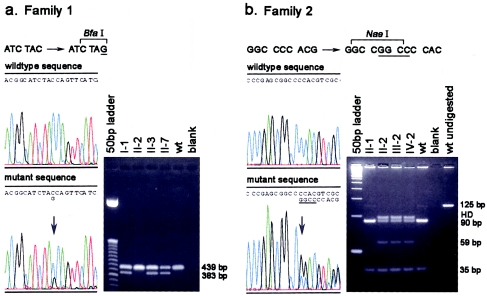Figure 4.
Mutation analysis in two families with hereditary lymphedema. Mutations in the FOXC2 gene were detected by direct sequencing of the PCR-amplified coding region of the gene. Results were confirmed by sequencing the reverse strand and by restriction-enzyme analysis. a, Sequencing revealed a TAC→TAG nonsense mutation (C297G) (arrow, left panel) in the proband (II-7) in family 1, creating a novel BfaI restriction site. The right panel shows the cosegregation of the novel restriction site with the LD phenotype. Fetus II-6 was also shown to have the mutation, by restriction digest analysis (not shown). A 439-bp region of the FOXC2 gene was PCR amplified and digested with BfaI. Products from normal alleles are not cut and remain 439 bp, whereas the mutant allele is cut into 383- and 53-bp fragments (not retained on gel). b, Sequence analysis revealing a 4-bp insertion in the proband (IV-2) in family 2. The GGCC insertion creates a shifted sequence beginning at the arrow (left panel). A novel NaeI restriction site is created by the insertion. The right panel shows the cosegregation of the NaeI fragments with the LD phenotype in family 2. PCR was used to amplify a 125-bp region of the FOXC2 gene (129 bp for the mutant allele). NaeI digestion of the PCR products results in 35- and 90-bp fragments for normal alleles, because of the presence of a naturally occurring NaeI site in the product. In alleles with the insertion, the 129-bp product is cut twice, generating two 35-bp fragments and a 59-bp fragment. Bands labeled “HD” show uncut heteroduplexes.

